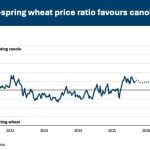RED DEER – Government officials should not dismiss a mass slaughter of older cattle as a way of boosting cattle prices and possibly reopening the border, says a southern Alberta farmer.
“To get our markets, we’re going to have to do here what they did in Regina in 1951,” said Howard Winberg, referring to a mass slaughter of cattle prompted by the discovery of contagious foot-and-mouth disease in southern Saskatchewan.
“They shot them. If we don’t do something pretty soon, we’re going to have a calamity at the bank,” Winberg said during the Wild Rose Agricultural Producers convention in Red Deer.
Read Also

Farmers urged to be grain-safe this fall
Working around grain bins comes with risk, from farmers falling to drowning in grain: Experts have five tips to help avoid grain-related accidents this harvest.
“I think it’s a very barbaric way of handling it, but we don’t have the ability to process them.”
He said killing all animals born before 1997, when the ruminant feed ban was put in place, may have a two-fold benefit:
- Help reopen international borders to Canadian cattle and lower the number of cull cows in Canada.
- Help boost sagging domestic beef prices because of the excess of cattle in the country.
“These old animals should be taken care of,” Winberg said.
Darcy Davis, vice-chair of Alberta Beef Producers, said there’s a world of difference between the discovery of foot-and mouth disease in cattle in Saskatchewan more than 50 years ago and the BSE crisis of today.
BSE isn’t a contagious disease and it would be difficult to tell the exact age of older cattle.
“We will base our decisions on both science and common sense,” he said.
It’s estimated there are 600,000 cull beef and dairy cows in Canada, not including older cows still in the herd over seven years old.
An Alberta government survey hopes to get a better handle on how many older cattle are in the province.
Alberta agriculture minister Shirley McClellan said the government will use the survey information to help make decisions on the best way to deal with older animals. However, the government doesn’t believe a mass slaughter of cattle is the answer.
“I’m not sure the public would appreciate the wholesale slaughter of healthy animals in this case. I think the public would prefer we use science and the best information we have.”
But McClellan said she’s not ruling out anything that helps get the beef industry back on its feet.
“We’ll entertain and discuss with the industry anything that makes sense on a scientific basis and on a consumer confidence basis.”
Cam Daniels, vice-president of the Canadian Beef Export Federation, said while he hopes politicians and industry base their food safety decisions on science, he knows science doesn’t always satisfy the public.
“Perception is something we have to deal with.”
Alberta Beef Producers president Arno Doerksen said no one is going to advocate a mass slaughter.
“We’ll consider reasonable responses and options that I think make sense within science. Our position has been let’s let science dictate our positions with regard to that type of thing. At this point I don’t think science points us in that direction.”














